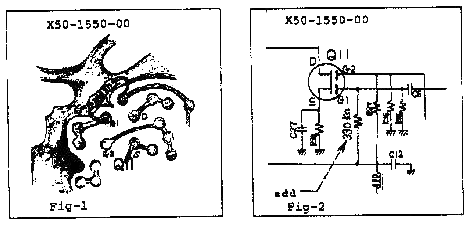Modifications for the Kenwood
TS-180

19-07-1998 TS-180S Trouble
Sheet
Author: Trio-Kenwood
Communication, inc.
Service Bulletin no. 61 (18-12-1979)
ALC deflection low Replace D21 on IF unit from 7.1 to 9.0V zener.
Readjust
all ALC pots.
IF #2 OUtput low Bridge R77 position, replace R78 with R77
470 ohms. See TKC service Bulletin.
RX Noise (OSC CAR leakage) Shorten
L31, L33 leads as much as possible.
Increase NB effectiveness Replace
L31, L33 for 33 uh to 27uh, with SHORT leads.
RX noise from strong
signals Replace L30 10uh on the IF with self shielding type (new part
L40-1035-21).
TX audio distortion Adjust T15 on the IF approx 1/2 turn
back, readjust all ALC pots up.
10 M PLL unlock change: R77 from 6.8 K to
4.7 K ohm, R94 from 8.2 K to 6.8 K ohm on the PLL unit.
TX audio
distortion Adjust 10 W bias for 150mA, 100 W bias for 100mA.
Unlocked all
bands Check L2, (Q2 B+) in the PLL unit.
FM'ing with DFC See service
bullein of 9/10 for L12, L13 change and add resistor and shield.
40 Mlow
alc, See bulletin 9/14 change C14, 17.

19-07-1998 TS-180S Use with a Linear
Amplifier
Author: Trio-Kenwood
Communication, inc.
Service Bulletin no. 817 (20-3-1980)
- Fast Protection with a Linear:
For complaints of fast protection,
such as when operating CW semibreak-in with a linear, check C73 at the base of
Q1 on the LPF unit X51-1180-00. If it is a 1uf, change to 3.3 uf, 25v or
greater. This will compensate for slow linear relay closure.
- Premature Protection
The radio should protect at 3:1 SWR, or at 24W
open (no) load. To test the protection circuit, load the radio at 24W into a
know 500 ohm dummy load through a Bird 43 wattmeter. Disconnect the load from
the wattmeter. The protection light should just lite. Adjust the protection
pot VR1 on the LPF unit for protectio at 24W with no load.
- For complaints of VOX CYCLING, MEMORY JUMP, READOUT JUMP, or TONE "BEEP"
at key up or down with a linear amp, suspect linear induced relay transients
entering the radio via the ASSY relay wiring.
For example, DRAKE L4B
linears before Serial Number 5500 do not have a quench diode across the DC
operated relay. Install a 1N4005 or equivalent across the relay in the linear
to eliminate the back EMF induced by the linear into the TS-180S. Similarly,
Henry linears also don't have a diode across the relay and may give these
symptoms when operated with a TS-180S.

19-07-1998 TS-180S Low Pass Filter Optional
Changes
Author: Trio-Kenwood
Communication, inc.
Service bulletin no. 41 (4-9-1979)
- Transmitter ALC levels may be increased by these optional component
changes. Check for correct component values when installing the CK-18
kit.
On the LPF Unit X51-1180-00 change:
7 MHz
C14 from 470pf to 390pf (CM93D2H391J)
C17 from 470pf to 390pf (CM93D2H391J)
18 and 21 MHz
C25 from 27pf to 39pf (CC45CH2H390J)
C26 from 82pf to 68pf (CC45CH2H680J)
C28 from 82pf to 120pf (CC45CH2H121J)
C29 from 27pf to 39pf (CC45CH2H390J)
24.5 and 28 MHz
C30 from 18pf to 39pf (CC45CH2H390J)
C34 from 18pf to 39pf (CC45CH2H390J)
All capacitors should be 500V silver mica or disc ceramic, 5%.
ALC
Adjustment. After these component changes, perform ALC alignments 4-4, 4-5,
and 4-6 as listed in the Service Manual. Be sure to adjust to spec.; incorrect
meter zero (4-4), output exceeding 95W (4-5), or failure to peak T1 (RF unit)
and L15 (IF unit) (4-6) will result in low or no ALC and possible future
damage to the power amplifier.
- Fast protection with a linear amplifier. While working in the LPF unit,
check the value of C73 (base of Q1). If it is 1uf, change to a 3.3 uf @ 25v dc
tantalum (CS15E1E3R3M). This will compensate fro slow linear amplifier relay
closure.
Note:
These changes are at the owners option and may not
be performed in warranty.

19-07-1998 BS-8 Alignment with the TS-180S
Transceiver
The SM-220/BS-8 scope combination are fully
compatible with the TS-180S transceiver. However, as the TS-180S does not have a
25kHz calibrator, BS-8 alignment will not be in accordance with the SM-220
Operating Manual.
Procedure:
Install the BS-8 in accordance with
the SM-220 Manual, however, leave the scope covers off until step 1 is completed
(If input alignment.) See note 1.2.
Perform steps 8.4.1, 8.4.2. steps
8.4.3, 8.4.4 do not apply to the TS-180S. After step 8.4.2. continue:
- With the Marker ON, turn the transceiver ON, and in the USB mode, any
band, you should hear the scope Marker directly injected into the IF.
Peak
T201, the BS-8 input IF transformer, for maximum signal into the TS-180S. This
transformer is not shown in Fig. 8-2, but is the only other adjustment on the
BS-8, and is located below the three identified sccess openings. If you cannot
hear the Scope Marker in the TS-180S, turn the marker off and tune a local
station on the 1.5 MHz band. Peak the drive control, and then peak T1 in the
BS-8 for maximum amplitude at scope center and equal roll-off at the display
edges. See note 1 Page 2.
- Turn of TS-180S, 1.5 MHz band, and tune to the local AM broadcast station
nearest 1.6 MHz.
- Enter this frequency in the M1 Memory. Depress the DSP/Diff pushbutton for
a differential display.
- Tune up and down approximately 100KHz, observing the scope display. Note
the verticale displacement of the original frequency to the left and right. If
equal, or linear displacement is obseved, stop.
- If the display does not shift equally when tuned up or down frequency,
adjust VR202 for linearity of scan width. Then reset to the center frequency
(by the cope Marker or retuning the transceiver). Reset TC201 if necessary.
Repeat two or three times for correct scope center frequency, and linear
display.
- Turn the TS-180S off, and the scope marker on. Switching between 100khz
and 20khz scan widths, the marker should appear at scoep center, and should
not shift. Repeat step 5 if there is a shift.
Notes:
- A Bs-8 previously aligned to a TS-820 or TS-820S need only have step 1.,
input alignment, performed.
- Preset TC201, VR201, VR202 at their center. When alignment is complete,
these adjustments should not be at their extreme limits. This will result in
unstable Pan display operation. Rather, they should be somewhat within their
center range.
Please make these changes in your service
manual.

19-07-1998 TS-180S CW Delay During VOX Memory
Operation
Author: Trio-Kenwood
Communication, inc.
Service Bulletin no. 803 (7-2-1980)
Some operators may report missing the first dit during CW VOX operation on
the memories. This will occur only in early units, and may be improved by
changing one capacitor in the DFC.
On the DFC VCO unit X50-1550-00, check C3 at the base of Q3. If C3 is a 22uF
electrolytic, change to a .01uf disc.
No adjustments are necessary.

19-07-1998 TS-180S Low 40M
ALC
9-14-79
Please annotate your service
manual.
Some operators may experience intermittent reduction or loss of
ALC, especially after several minutes transmit time.
On the LPF unit
X51-1180-00, change C14, C17 from 470 pf to 390 pF. Check ALC level and adjust
if necessary, per section 406 ALC meter adjustmet, TS-180S service
Manual.
New part: CM93D2H390J 390pF +/- 5% 500v mica or
ceramic
Please annotate your Service Manual.

19-07-1998 TS-180S VFO
Stability
Author: Trio-Kenwood
Communication, inc.
Service Bulletin no. 839 (29-12-1980)
VFO drift characteristics may be improved by changing a capacitor value and
location in the VFO.
- Begin by calibrating the analog dial to the Digital Display at 14.000.0
MHz. DO NOT disturb this calibration while working on the VFO.
- Turn off the main power and remove the VFO unit by two 3mm hex head
bolts.
- Withdraw out the front panel and unplug the leads.
- Remove the VFO cover by five Phillips head screws.
- Remove C17 from the PCB. This may be cut flush to the board.
- Install the 18 pF yellow cap across the tank coil terminals. Position the
cap near the coil.
- To reassemble, performs steps 3, 2. Snug all VFO case screws. A later
complaint of frequency jump would indicate a loose VFO shell.
- Turn on the radio and check analog dial calibration against the Digital
Display. Adjust VC1 (center of the Seal Tape) only if the zero-point has
moved.
- VFO linearity final check: The Digital readout and analog dial should
agree to within +/- 2 kHz at every 100 kHz dial point.
New Part: 18 pF CC45RC1H180J
Old Part: 18 pF CC45PG1H180J |
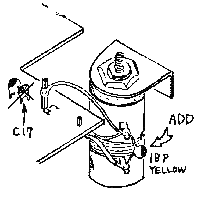 |
Analog Dial Calibration
- Calibrate the main knob to 50 kHz analog against the digital
display.
- Note the digital error. If it is more than 2 kHz adjust the VFO trimmer
cap VC1 (center under the sealing tape) to exactly 50.0 on the digital
readout.
- Turn the main knob to 450 analog. If the digital error is less than 2 kHz
it is in spec. If the digital error greater, proceed:
For instance, if
the digital error is 14.454.0 (plus 4 kHz), multiply the error times 4 (16
kHz) and adjust the VFO trimmer cap to the desired frequency (14.450.0) LESS
the error, or 14.434.0. Next, adjust the VFO inductor L1 (front under the
sealing tape) back up to the desired frequency of 14.450.0.
- If the error in step 3 was in the minus direction, reverse the direction
of correction adjustment.
- VFO linearity final check: The digital readout and analog dial should
agree to within +/- 2 kHz at every 100 kHz dial point.
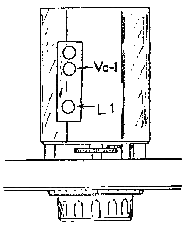

19-07-1998 TS-180S Increase of RX Audio
Output
Author: Trio-Kenwood
Communication, inc.
Service Bulletin no. 47 (30-7-1979)
RX audio output from the TS-180S may be increased a total of 4.7 dB. This is
an optional change which you can make at the owners request.
On the IF unit X48-1240-00 change components:
R206 2.2K change to 1 K ohn
R207 2.2K change to 4.7 K ohm
On the AF Gain Control, between pin 1 and 3;
C4 .047uF change to .027uF mylar
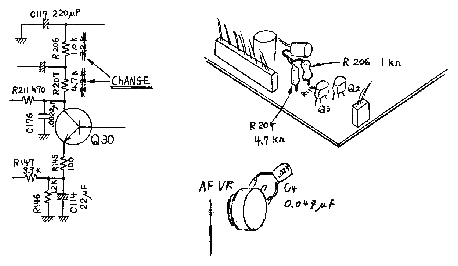
Please notate your service manual.

19-07-1998 TS-180S IF output #2 Level Change
for SM-220
Author: Trio-Kenwood
Communication, inc.
Service bulletin no. 42 (4-9-1979)
TS-180S owners who desire to operate an SM-220 for IF output display will
require a wiring change to the IF unit X48-1240-00. No additional parts and no
adjustments are required.
Remove R77, 470 ohm, and replace with wire jumper. Remove R78, 56 ohm, and
replace with old R77. The 56 ohm resistor is not used.
With AGC on, gain should be adequate for about a 3/4 screen display.
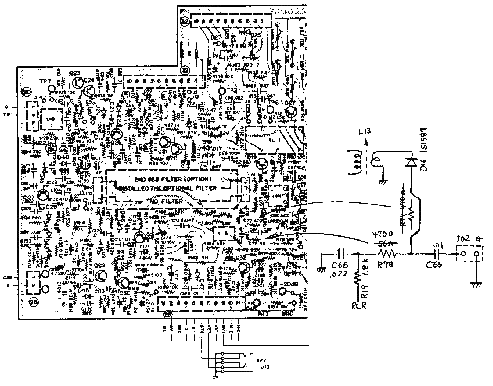

20-02-2000 TS-180S DFC hum with
PS-30
Author: Trio-Kenwood
Communication, inc.
Service bulletin no. 36 (10-7-1979)
Some TS-180S users may report erratic DFC, and audio hum. You will find they
have placed the PS-30 to the left of the transceiver. Hum is induced from the
PS-30 into the DFC.
We are awaiting modification and production changes. Mean while, please be
award of this problem. Temporarily moving the PS-30 to the right hand side of
the transceiver will cure the problem. Spacing the two units with the SP-180, or
just separating at least two inches will also cure the hum. When full
information is available, we will follow up.
Please advise your Service and Sales personal.


20-02-2000 TS-120S, TS-180S phone patch
terminal addition
Author:
Trio-Kenwood Communication, inc.
Service bulletin no. 44 (6-9-1979)
Kenwood recommends the PC-1 Phone Patch for all of our radios. Most other
phone patches will work satisfactorily without any modification to the radio,
requiring only an external speaker connection, and that the Mic line be run
through the patch.
For those operators who desire a Patch input similar to the TS-520S or
TS-820S, an input connection and terminal must be added at the Mic input preamp
circuit.
Fixed Divider
Use a 100Kohm in series, with a 10Kohm to ground on the input side of the
100Kohm resistor. Use shielded line, and connect as follows:

TS-120S
On the IF Gen unit X49-1110-01 install the fixed divider at the junction of
R43 10K, C42 100pF, & C43 1uF (input of Q18). Add an RCA jack, or use remote
pins 7 and ground for input.
TS-180S
On the IF Gen unit X48-1240-00 install the fixed divider at the junction of
R167 10K, C128 .001uF, & C129 1uF (input of Q32). Add an RCA jack, or use
remote pins 7 and ground for input.

18-03-2000 TS-180S DFC
Author: Trio-Kenwood Communication,
inc.
Service Bulletin no. 56 (10-09-1979)
For complaints of either induced power supply hum, or intermittent frequency
stability while using the DFC, perform the following changes to the VCO unit
X50-1550-00:
- Install a 330 Kohm resistor between Q11 G1 & the 8V line.
Connect
from L7 at C12 to Q11 G1, at R35.
- Replace L12 68uH with new part L40-6831-21.
- Replace L13 150 ÁH with new part L40-1541-27.
- Install magnetic shield as illustrated. Use the two existing screws, plus
double faced tape to prevent vibration.
No adjustments are necessary.
Note: On page 37 of the Service Manual, the VCO Board view shows reversed
callouts for Q11 & Q15. D & S, and G1 & G2 are transposed.

This bulletin supercedes previous DFC bulletins of 7/10/79 and
7/13/79.

18-03-2000 TS-180S DFC
Instability
Author: Trio-Kenwood
Communication, inc.
Service Bulletin no. 67 (13-7-1979)
TS-180S operators may report intermittent DFC instability, especially at 10
KHz even points. This may be characterized in some cases as PM'ing.
On the VCO unit X50-1550-00, install a 330 Kohm resistor between Q11 G1, and
the 8V line. Connect from L7 at C12 to Q11 G1. at R35.
No adjustments are necessary.
Note: On page 37 of the Service Manual, the Board view of the VCO unit
contains reversed callouts for Q11 & Q15 FET's, D & S, and G1 & G2
are transposed.
